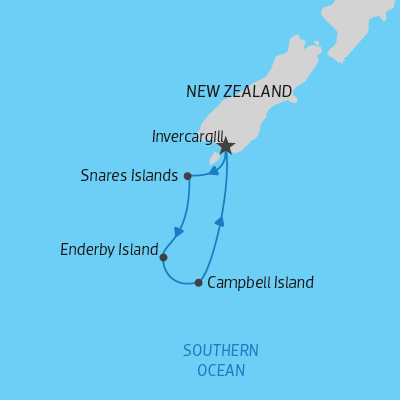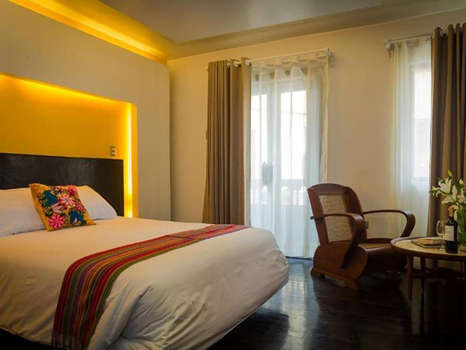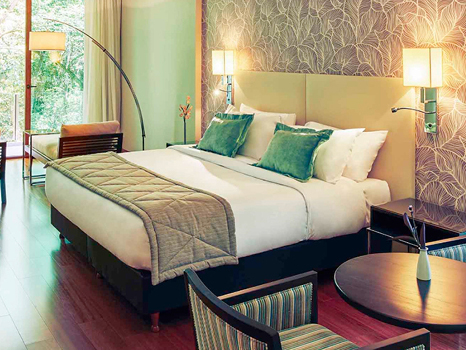FROM PRICE INFORMATION
Based on 21 December 2025 Departure
Superior Triple Cabin
Pricing and Availability last updated 1 Oct 24
Trip Code: NZHEFS
DIFFICULTY RATING: 2 (light adventure)
Start: Invercargill, New Zealand
Finish: Invercargill, New Zealand
SHIP: Heritage Adventurer
Subantarctic Islands of New Zealand
28/12/2024, 21/12/2025
All Meals Onboard the Ship
Group transfers from Bluff port to Invercargill or Queenstown airport
Cabin on board ship

Daily Excursions, Zodiac Cruising, Onboard Expert Lectures & Briefings by the Experienced Expedition Team
NOTE: Itinerary is subject to change depending on government regulations, weather & ice conditions
Embark on an incredible expedition to the Subantarctic islands of New Zealand. These 'forgotten' islands are often omitted from the mind of the exploratory traveller. However, despite their low profile, these islands are some of the most remarkable wildlife reserves in the Southern Ocean and designated UNESCO world heritage sites. Departing from Invercargill on board the Heritage Adventurer you will explore islands dotted with honey-combed seabird cliffs, windswept Rata forests, flowering fields of incredible 'megaherbs' and unforgettable wildlife experiences from Snare crested Penguin to majestic Royal Albatross. Discover one of the most pristine ecosystems that truly to this day unheard of.
*SPRING SAIL PROMOTION -Save up to 15% off on selected cabin categories on the selected 25/26 season Antarctica voyages aboard Heritage Adventurer, when you book by 29 November 2024. BOOK NOW - LIMITED TIME ONLY! Excludes landing fees and optional extras, cannot be used in conjunction with any other offer. Offer is subject to availability and can be changed or withdrawn at any time.
PLEASE NOTE: Pricing is subject to change and availability at the time of booking. Contact us for more information.

Guests should make their way to the designated hotel where we will spend the first night of the expedition. This evening there will be an informal get-together at the hotel for dinner; an excellent opportunity to meet fellow adventurers on your voyage and some of our expedition team.

Today we enjoy breakfast in the hotel restaurant and have the morning free to explore Queenstown before returning to the hotel for lunch and departing for the Port of Bluff to embark your ship. You will have time to settle into your cabin and familarise yourself with the ship; we will also take the opportunity to conduct a number of safety briefings. You are invited to join the expedition team in the Observation Lounge and up on the Observation Deck as we set our course to Campbell Island and our adventure begins. We will sail past Ruapuke Island, formerly a local Maori stronghold supporting a population of over 200 people. We will also be able to see Stewart Island. Despite appearing quite small on most maps it is really quite large and has a 700 kilometre coastline. Seabirds that we may encounter at this early point in the voyage include: albatross, petrels, cormorants, gulls and Little Blue Penguins.

As we make our way through the Southern Ocean we take the opportunity to learn more about the flora and fauna as we prepare for our arrival at Campbell Island. En route there are great birding opportunities which may include the Wandering Albatross, Royal Albatross, Black-browed Albatross, Light-mantled Sooty Albatross, Salvin’s Albatross, Campbell Island Albatross, Northern and Southern Giant Petrel, Sooty Shearwater and Little Shearwater. There should be plenty of petrels and again the hard to identify prion species. We can expect some of the best pelagic birding on this leg of the journey from Bluff to Campbell Island with great views during the crossing.

We have a full day to explore Campbell Island, New Zealand’s southernmost Subantarctic territory. Its history is as rich and varied as the other islands we visit. Discovered in 1810, it was soon occupied by sealers who introduced rats and cats. Farming followed from 1895 to 1934 when it was abandoned. Coastwatchers were stationed on the island during the war and at the end of the war the station was taken over by the New Zealand Metrological service. They maintained a manned weather/ research station there until 1995. In the early 1970s the removal of farm animals commenced and all were eventually removed by 1990. The vegetation recovered quickly and the cats died out naturally. In a very ambitious (and never before attempted on such a large scale) eradication programme the New Zealand Department of Conservation successfully removed the rats. With the island declared predator free, the way was clear to reintroduce the endangered Campbell Island Flightless Teal, which had been rediscovered on an offshore island in 1975. Snipe, which were formerly unknown from the island but were discovered on another offshore island, recolonised the islands themselves. The vegetation which the great English botanist Sir Joseph Hooker described in 1841 as having a “Flora display second to none outside the tropics” is flourishing and is nothing short of spectacular. We will offer a number of options which will enable you to explore the island including an extended walk to Northwest Bay. There will also be an easier walk to the Col Lyall Saddle. All of these options will allow you the opportunity and time to enjoy the Southern Royal Albatross which nest here in large numbers. We also visit areas of the island which contain outstanding examples of the megaherbs for which the island is renowned.

In the south of the archipelago there is a very large sheltered harbour rich in human history including shipwrecks, treasure hunters, Coastwatchers and, of course, scientific parties. We plan to arrive mid-morning entering the harbour through the eastern entrance which is guarded on both sides by dramatic cliffs and climb there will be an opportunity to Zodiac cruise along the coast of Adams Island, Western Harbour and Victoria Passage. Other options include the Tagua Bay Coastwatcher’s hut and lookout which was occupied during the Second World War. We could visit Epigwatt and the remains of the ‘Grafton’ which was wrecked here in 1864. All five men aboard survived and lived here for 18 months before sailing their modified dinghy to New Zealand to get help. Two of the survivors wrote books about their ordeal, their first-hand accounts tell us a lot about their time here. Later this evening we will sail up the eastern coast, making our way to Port Ross in preparation for our landing at Enderby Island.

The Auckland Islands group was formed by two volcanoes which erupted some 10-25 million years ago. They have subsequently been eroded and dissected by glaciation creating the archipelago as we know it today. Enderby Island is one of the most beautiful islands in this group and is named after the same distinguished shipping family as one of our own vessels. This northern most island in the archipelago is an outstanding wildlife and birding location and is relatively easy to land on and walk around. The island was cleared of all introduced animals (pests) in 1994 and both birds and the vegetation, especially the herbaceous plants, are recovering both in numbers and diversity. Our plan is to land at Sandy Bay, one of three breeding areas in the Auckland Islands for the Hooker’s or New Zealand Sea Lion, a rare member of the seal family. Beachmaster bulls gather on the beach, defending their harems from younger (ambitious) males, to mate with the cows shortly after they have given birth to a single pup. Hooker’s or New Zealand Sea Lion numbers are in a slow decline, for reasons which are not obvious but most probably connected with a nearby squid fishery. During our day ashore there will be several options, some longer walks, some shorter walks and time to spend just sitting and enjoying the wildlife. The walking is relatively easy. A boardwalk traverses the island to the dramatic western cliffs, from there we follow the coast and circumnavigate the island. Birds that we are likely to encounter include the following species: Southern Royal Albatross, Northern Giant Petrel, Auckland Island Shag, Auckland Island Flightless Teal, Auckland Island Banded Dotterel, Auckland Island Tomtit, Bellbird, Pipit, Red-crowned Parakeet, Yellow-eyed Penguin and Light-mantled Sooty Albatross. There is also a very good chance of seeing the Subantarctic Snipe. Other more common species we will see include the Goldfinch, Song Thrush, Blackbird, European Starling, Red-billed Gull and Redpoll. On Derry Castle Reef we will look for migratory waders which could include Bar-tailed Godwit, Turnstone and possibly vagrants.

The closest Subantarctic Islands to New Zealand, they were appropriately called The Snares as they were once considered a hazard for sailing ships. Comprising of two main islands and a group of five islands called the Western Chain; they are uninhabited and enjoy the highest protection as Nature Reserves. It is claimed by some that these islands are home to more nesting seabirds than all of the British Isles together. We plan to arrive in the morning, and as landings are not permitted, we will Zodiac cruise along the sheltered eastern side of the main island if the weather and sea conditions are suitable. In the sheltered bays, we should see the endemic Snares Crested Penguin, Snares Island Tomtit and Fernbirds. There are hundreds of thousands of Sooty Shearwaters nesting on The Snares; the actual number is much debated. Buller’s Albatross breed here from early January onwards. There will be opportunities to view the forests of large tree daisy Olearia lyallii which forms a canopy over much of the island group. Tonight we enjoy a farewell and celebratory dinner with newfound friends with time to reflect on a wealth of new experiences and recap on what amazing wildlife, plant life, landscapes and history we have enjoyed.

Spend the morning exploring Stewart and Ulva Islands. Abundant in both history and wildlife, Ulva Island has remained predator-free since 1997, making its bird songs and wildlife among the finest in New Zealand. Bid your farewells and then be transferred to either Invercargill or Queenstown Airport. To accommodate unexpected delays, we kindly request that you refrain from booking any onward travel from Invercargill before 3pm or before 6pm from Queenstown. Please note: Throughout our journey, circumstances may necessitate or present opportunities to deviate from the proposed itinerary. Such deviations could be due to inclement weather or unforeseen chances for spontaneous excursions. Your Expedition Leader will ensure you are kept thoroughly informed. Landings at the Subantarctic Islands of New Zealand are strictly regulated by permit, under the administration of the Government of New Zealand. It's important to note that no landings are permitted at The Snares.
Uncover the mysteries and pristine sites of the 'forgotten islands' a truly wonderful ecosystem close to home that few travellers truly know exist.
You will visit a number of unique islands each with incredible and contrasting sights, from dramatic honey-combed sea bird cliffs, wild fields of impressive megaherbs and immersive history from shipwrecks, treasure hunters and scientific parties.
This Subantarctic expedition is the perfect experience for the adventurer traveller - who seeks and isolated and pristine expedition experience perfect for travel from Australia and New Zealand.

The Heritage Adventurer is a true expedition vessel of exceptional quality and design. Built in 1991, this 140-guest expedition vessel was purpose built for polar expeditions. Combining a high passenger ship ice class rating (1A Super) and a rich expedition history including most of the northern and southern Arctic and Antarctic, the Adventurer superimposes the notion of a truly tried and tested expedition vessel. Each voyage on board the Adventurer is entirely unique. Your expedition crew will meticulously plan and design each exploration in true expedition style. A fleet of 14 zodiacs ensures that every guest can maximise their expedition experience once on board. Guests will enjoy a personalised experience on one of the industry’s most iconic polar vessels. Well-appointed ship ideally suited to expeditions Complete with stylish accommodations, two restaurants and a bar and lounge area guests will find a number of avenues for relaxation. Furthermore, the ship's Open Bridge policy means that guests will be able to first-hand experience the expedition experience from the eyes and shared experiences of the captain and crew. Exploration is the top focus Having held records for the most northern and southern Arctic and Antarctic navigations, and for traversing both the Northwest and Northeast Passages, the purpose-built Heritage Adventurer was built in Finland for the purpose of Antarctic and Arctic expeditions. Luxury amenities After a day of exploration, guests can relax in the heated outdoor swimming pool or one of two Jacuzzis on the rear deck. For the more active, hit the gym before unwinding in the sauna. Guests can also enrich their knowledge at the Citizen Science Centre and then indulge in culinary delights at one of two restaurants. Passengers can also simply relax in comfort across multiple observation areas, admiring wildlife or breathtaking landscapes. In addition to its advanced features, the Douglas Mawson offers an array of amenities helping to connect fellow travellers, enhancing the floating base camp experience. Inviting onboard amenities A host of guest lectures from botanists, naturalists, historians and experts will be shown in the ships Presentation Theatre or guests may simply choose to unwind in the library, heated saltwater pool, sauna room, gym or enclosed hot tub. Comfortable rooms Spacious cabins and suites, with large picture windows or portholes, are all outer facing. This means all guests can enjoy Antarctic views as they travel, with room configurations flexible to suit triples, twins, singles, or couples. WHY WE LOVE THE HERITAGE ADVENTURER
FEATURES OF THE HERITAGE ADVENTURER
Ice Class:
Length: 124m
Breadth: 18mMax
Draft: Cruising
Speed: 15 Knots
Electricity: Passenger
Capacity:140
View Ship Details
We believe that appropriate accommodation should add to the authentic travel experience, as well as providing utmost enjoyment. For that reason our accommodation is scrutinised by our staff on the ground frequently, ensuring the properties adhere to our high standards. This key will help you understand the levels of accommodation available on this tour.

Comfortable properties with dependable facilities and service.

Comfortable properties with dependable facilities and service.

Luxurious properties with impeccable facilities and service.
| Forgotten Islands of the South Pacific | Heritage Adventurer from USD 5,483 | ||
| Departing | Ending | Duration |
|---|---|---|
| 28 Dec 2024 | 04 Jan 2025 | 8 |
| 21 Dec 2025 | 28 Dec 2025 | 8 |
From USD 31,500
Was USD 3,750
NOW From USD 3,000
Prices are based on per person, twin share* (unless otherwise stated for triple/quad cabins)
Prices are correct at time of publishing but are subject to change at any time.
Itinerary is subject to change depending on government regulations, weather and ice conditions
* Landings at the Subantarctic Islands of New Zealand are by permit only as administered by the Government of New Zealand. No landings are permitted at The Snares.
Cabin accommodation on board ship
All meals whilst on board
Guiding and lectures by experienced expedition crew
All scheduled landings and excursions by zodiac
All miscellaneous service taxes and port charges
International flights
Airport transfers, taxes and excess baggage charges unless specified
Meals other than those specified in the pre-departure information
Pre or post cruise travel expenses
Any optional activities not mentioned in itinerary
Visa and reciprocity fees (if applicable)
Travel insurance
All items of a personal nature
Laundry and drinks
Customary gratuities for staff and expedition crew
Available on request. Subject to availability. Please contact us for more information.
Departure date, fuel surcharges, cabin category, currency fluctuations, seasonality and availability.
Based on 21 December 2025 Departure
Superior Triple Cabin
Pricing and Availability last updated 1 Oct 24